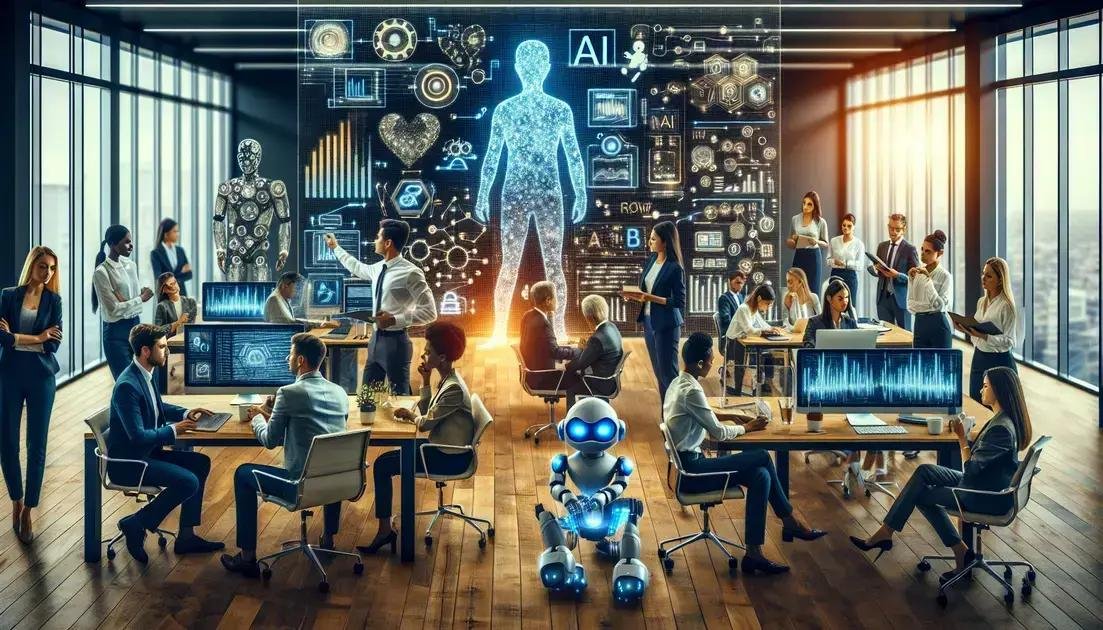Generative AI for businesses is a game-changer in today’s digital landscape.
This innovative technology not only enhances creativity but also boosts operational efficiency.
As companies strive to differentiate themselves, understanding the applications of generative AI becomes crucial.
In this blog post, we will explore its impact, implementation strategies, and real-world success stories that illustrate its transformative potential.
Understanding Generative AI and Its Impact
Generative AI is a revolutionary technology that enables machines to create content, designs, and solutions similar to human capabilities. Understanding the principles of Generative AI is crucial as it reshapes how businesses operate. That said, Generative AI works through advanced algorithms and models like Generative Adversarial Networks (GANs) and Variational Autoencoders (VAEs), allowing for the production of new data instances that are similar to the training data.
One of the significant impacts of Generative AI is its ability to automate creativity. Businesses can leverage this technology to generate marketing content, design products, and even curate music and art. This can save time and resources while enhancing creativity. For example, marketing teams can use Generative AI to develop targeted advertisements by quickly analyzing consumer data and generating personalized messages.
Another key aspect of Generative AI is its role in improving decision-making processes. By analyzing vast amounts of data, Generative AI can provide insights that humans might overlook. These insights can help businesses predict market trends, understand customer preferences, and optimize operational efficiency.
Moreover, Generative AI can facilitate innovation by enabling a rapid prototyping process. Companies can create multiple versions of a product or a service in record time, allowing for more extensive testing and feedback loops. As a result, businesses can bring new products to market faster and with reduced risks.
As we look towards the future, the influence of Generative AI on business growth will likely expand even further. Companies investing in this technology can expect significant competitive advantages, especially in sectors that rely heavily on content generation and design, such as advertising, entertainment, and product development. Understanding the nuances of Generative AI today prepares businesses for the opportunities and challenges of tomorrow.
How Businesses Can Implement Generative AI

Generative AI presents innovative opportunities for businesses looking to enhance their operations and drive growth.
Step 1: Identify Business Needs – To successfully implement generative AI, companies must first assess their specific goals and challenges. Understanding what processes can be improved or automated is crucial.
Step 2: Select the Right Tools – There are various generative AI tools available in the market. Businesses should choose ones that align with their objectives. Consider factors such as scalability, user interface, and integration capabilities.
Step 3: Develop a Strategic Plan – Create a roadmap that outlines how generative AI will be integrated into existing workflows. This should include timelines, budget considerations, and resource allocation.
Step 4: Train Your Team – It’s essential to ensure that employees are trained in utilizing generative AI effectively. Offering workshops or training sessions can help staff feel more comfortable with new technologies.
Step 5: Monitor and Optimize – After implementation, continuously monitor the performance of generative AI tools. Collect data on their effectiveness and make necessary adjustments to optimize results.
By following these steps, businesses can leverage generative AI to unlock new potentials for growth and innovation.
Case Studies: Success Stories of Generative AI
Generative AI is revolutionizing the way businesses operate, leading to significant innovations and success stories across various industries. Noteworthy case studies illustrate how companies leverage this technology to achieve remarkable outcomes.
One compelling example is Company A, which enhanced its customer service operations by integrating a generative AI chatbot. This solution not only reduced response times but also improved customer satisfaction ratings by 35%. The AI system was trained on historical interactions, enabling it to provide personalized responses.
Another success story comes from Company B, a marketing agency that utilized generative AI to create compelling content at scale. By automating the content generation process, they increased their output by 50% while maintaining high-quality standards. This allowed their team to focus on strategy and creative aspects of their campaigns.
Company C has applied generative AI in its product design, utilizing AI models to generate design prototypes based on customer feedback and market trends. This approach reduced the product development cycle by 30%, enabling faster time-to-market and increased revenues.
The potential benefits of generative AI extend to Company D, which harnessed predictive analytics capabilities of AI to optimize its supply chain. By forecasting demand more accurately, they achieved a 20% reduction in inventory costs.
These case studies not only reflect the transformative power of generative AI but also provide a roadmap for businesses looking to explore similar avenues for growth and efficiency.
The Future of Generative AI in Business

As businesses continue to evolve, Generative AI stands at the forefront of innovation, reshaping traditional models and paving the way for unprecedented growth opportunities. This technology enables companies to create original content, design, and solutions, optimizing operations in ways previously deemed impossible.
A key aspect of Generative AI is its ability to enhance decision-making processes. By analyzing vast amounts of data and identifying patterns, this AI can deliver insights that lead to more informed strategies and improved outcomes. Companies that embrace these insights are likely to outpace competitors who rely on outdated methods.
Furthermore, Generative AI can significantly reduce costs. Businesses can automate repetitive tasks, allowing employees to focus on more strategic initiatives. This leads to increased efficiency and productivity, as resources are allocated more effectively.
In terms of customer engagement, Generative AI offers tools that personalize experiences at an individual level. By generating tailored recommendations or content, businesses can enhance customer satisfaction and loyalty. Engaging customers with relevant information keeps them coming back, ultimately driving sales.
Looking ahead, the integration of Generative AI into business practices is expected to evolve. Companies will likely explore deeper functionalities, such as predictive modeling, where AI anticipates market trends and customer behavior. This proactive approach will allow businesses to stay ahead of the curve.
As technology advances, ethical considerations will also come into play. Businesses will need to balance innovation with responsible use of AI. Setting guidelines to ensure that AI-generated content aligns with company values and avoids bias will be critical.



